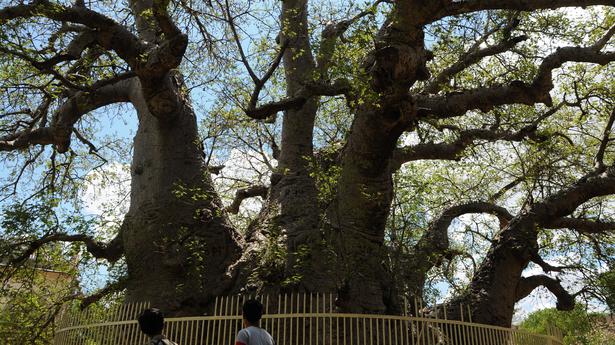
Bereft of attention, 430-year-old Hathiyan ka Jhad stands alone
The Hindu
Ancient Baobab tree on Golconda Fort premises misses attention of visitors, thanks to govt. failure to promote it
Residing in the tranquil environs of Naya Quila on the Golconda Fort premises is the 430-year-old African Baobab (adansonia digitata), whose history remains a mystery.
Touted to be one of the biggest Baobabs outside Africa and Australia, the mammoth tree is popular as ‘Hathiyan ka Jhad’ in local parlance (literally translating to elephant tree) as its gnarled, folded trunk resembles an elephant. Despite the majestic features, it misses the attention of thousands who visit the historic Golconda Fort.
This tree with a thick trunk of 25 metres in circumference and a height of 79 feet originated from Madagascar. It is believed that it was planted by wandering friars during their stay at Golconda. The trunk is hollow on the inside, and at least 40 persons can fit in it. A gang of 40 notorious thieves, it is said, took shelter inside the hollow trunk during the day and committed offences at night in the Golconda Sultanate.
Though protected by the Archaeological Survey of India (ASI) with an iron fence around it, this tree has been enclaved in the Hyderabad Golf Club. For a reason, visitors find it difficult to get closer to the centuries-old tree assuming it is private property.
“I have not seen a single day when tourists thronged this place. Hardly one or two visitors, mostly locals, come here at times. And there are days where no one visits,” says Sanjeev Kumar, a private security guard of Hyderabad Golf Club.
With the increasing demand from environmental activists to protect the tree and complaints of locals causing damage, a few years ago, the ASI declared it a ‘protected monument’ to be of national importance. Following the advice of a local ‘hakeem’ that it had aphrodisiac value, the locals started chipping away the bark and damaging the tree. Many even carved their names and that of their loved ones on the tree trunk.
“Whoever destroys, removes, injures, alters, defaces, imperils or misuses this monument shall be punishable with imprisonment which may extend to two years or with a fine up to ₹1 lakh or both,” the ASI says. Right behind that tree, one can never miss the sight of an ancient mosque which was reportedly built by Mulla Khayali, a noted poet and calligraphist during Ibrahim Qutub Shah Wali’s reign in 1569 AD.

 Run 3 Space | Play Space Running Game
Run 3 Space | Play Space Running Game
 Traffic Jam 3D | Online Racing Game
Traffic Jam 3D | Online Racing Game
 Duck Hunt | Play Old Classic Game
Duck Hunt | Play Old Classic Game

















